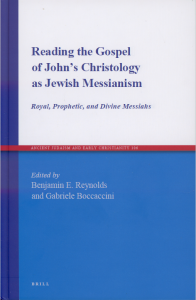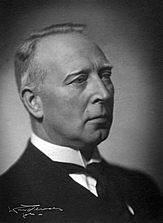 A recent publication with a challenging title and edited by Benjamin E. Reynolds and Gabriele Boccaccini is Reading the Gospel of John’s Christology as Jewish Messianism: Royal, Prophetic, and Divine Messiahs. How could that be? The Gospel of John is widely considered the most Christian-theologically advanced of the gospels and even anti-Jewish.
A recent publication with a challenging title and edited by Benjamin E. Reynolds and Gabriele Boccaccini is Reading the Gospel of John’s Christology as Jewish Messianism: Royal, Prophetic, and Divine Messiahs. How could that be? The Gospel of John is widely considered the most Christian-theologically advanced of the gospels and even anti-Jewish.
. . . in the Gospel of John, Jesus has descended from heaven, has been sent by the Father, is one with the Father, and is the only begotten of the Father. This Johannine portrayal of Jesus as the divine Son of God is thought to have been possible only in later Christian thought. . . .
. . . scholars do not deem John’s Christology to reflect Jewish messianic expectation, at least directly. Rather, John’s Christology is understood to reflect a Johannine version of the Synoptic Jesus set in the context of late first-century intra-Jewish diaspora dialogue and conflict or less specifically a Christianized or theologized development of Jewish messianic expectation.
. . . For many, John’s high Christology indicates its derivation from the community, which in turn negates its historicity. How much more problematic then is it to read the Gospel of John’s Christology as a form of Jewish Messianism? (16f)
Yet the discovery of the Dead Sea Scrolls has exposed certain similarities between the Gospel of John and some form of early Judaism in Palestine.
The challenge for Johannine scholarship has been where to go and what to do after noting John’s relationship with early Judaism. (18)
Benjamin Reynolds suggests the reason scholars stop short after doing little more than remarking upon certain points in common is that to go further
means traveling into uncharted waters, into places that Johannine scholarship does not go, such as reevaluating the possibility of historical evidence in John’s Gospel, the context in which the Gospel was written, and the height of its Christology.
Reynolds can say that “scholars almost without exception” address the Gospel of John as an instance of “early Christian (and thus not Jewish) belief in the Messiah.”
Attempts at Using John as Evidence for Jewish Messianism

Sigmund Mowinckel
Mowinckel cites
- John 4:25 along with Ps. Sol. 18:8-10 and 1 En. 49:3 to indicate Jewish and Samaritan belief that the Messiah would teach people “a right understanding of the law.’
- John 4:25 and 6:14 as evidence that the Messiah is the Prophet: “This passage [6:14] seems to imply that ‘the Prophet’, simpliciter, was a title of the Messiah.”
- John 1:21,25 as one of a number of examples that indicate that it was “presupposed in the Gospels as a common Jewish belief” that Elijah would precede the Messiah.
- John 7:41-42 . . . with other texts as an example of Mic. 5:1 giving rise to the idea that the Messiah would originate from Bethlehem.
When the people came to the conclusion that Jesus was truly ‘the Prophet that should come into the world’, the natural consequence was that they should proclaim Him king (John vi, 14f.). Thus, the Messiah is ‘the prophet’ . . . This passage seems to imply that ‘the Prophet’, simpliciter, was a title of the Messiah. This is in harmony with the fact that Old Testament passages which spoke, or seemed to speak of a special prophet in the future (like Malachi’s prediction of the return of Elijah, or the reference in Deuteronomy to the coming of a prophet like Moses), were by some interpreted Messianically, whereas other [Jewish] scholars took them to refer to a prophetic forerunner of the Messiah (see above, pp. 298ff). — Mowinckel, p. 322
Mowinckel, Sigmund. 1956. He That Cometh. Translated by G. W. Anderson. New York; Nashville: Abingdon Press.

Marinus de Jonge
If statements made by Jewish opponents or sympathizers in the Fourth Gospel do not agree with expressions or conceptions found in the Jewish sources, or show only partial agreements, we may not exclude the possibility that the Gospel, as only source, has preserved truly Jewish notions and beliefs. After all, the Jewish material is variegated, and very scanty and haphazard. Yet the Johannine material can only be used to fill in the gaps or to correct the picture after due allowance has been made within the Fourth Gospel. (Jonge, p. 79)
Since the majority of statements, particularly in John 7, come from the Jewish crowd, de Jonge argues that these statements are “a complete misunderstanding” or “they represent an inadequate formulation of belief.” The Gospel, thus, attempts to ignore, reinterpret, or correct such insufficient Jewish messianic understandings. (25)
Jonge, Marinus De. 1977. Jesus: Stranger from Heaven and Son of God: Jesus Christ and the Christians in Johannine Perspective, trans. John E. Steely. Missoula, Mont.: Scholars Press.
Dietmar Neufeld
Similar to Marinus de Jonge. The messianism of the Gospel of John has grown out of reflection on sectarian Jewish ideas of the messiah, the same ones that are raised by the Jews and then “corrected” by Jesus in the gospel.
Richard Bauckham
[H]e contends that the messianism of the Fourth Gospel corresponds to the myriad of messianic beliefs in the first century.

William Horbury
The passages he discusses are
- John 1:45 (“we have found the one of whom Moses wrote in the law and also the prophets”)
- and 12:34 (“We have heard from the law that the Christ remains forever; how do you say that it is necessary for the Son of Man to be lifted up? Who is this Son of Man?”).
Regarding 1:45, Horbury notes the expectation that the Messiah was prophesied in the law,
and regarding 12:34, he points out the association of the Messiah with the Son of Man, claiming that the crowd’s question indicates an association between the Messiah and the Son of Man.
Horbury posits that the crowd’s question “Who is this Son of Man?” does not derive from ignorance of the Son of Man idea but from the claim that the Son of Man is to suffer. Pre-Christian Jews, Horbury indicates, believed from the law and Daniel 7 that the Son of Man was to conquer rather than suffer.
Horbury, William. 2003. Messianism Among Jews and Christians: Biblical and Historical Studies. London; New York: A&C Black.
Messianic Texts and Themes in the Gospel of John
If you are a bit rusty on the Gospel of John here is a list of “primary texts that serve as important links to Jewish messianic expectation in the Gospel of John”:
• John the Baptist’s denial that he is the Christ, Elijah, or “the prophet” (John 1:19-21; cf. 3:28)
• Andrew’s declaration to Peter: “We have found the μεσσίαν” (1:41)
• Philip’s declaration to Nathanael: “We have found the one of whom Moses in the law and the prophets wrote” (1:45)
• Nathanael’s exclamation “You are the Son of God, the King of Israel” (1:49)
• Jesus’s statement to the Samaritan woman that the one speaking with her is the μεσσίας (4:25)
• the crowd’s claim that Jesus was the prophet who was to come into the world and their subsequent attempt to make him king (6:14-15)
• the crowd’s claim that when the Christ comes no one will know where he is from (7:27)
• the expectation by the crowd that the Christ will do signs (7:31; cf. 10:41)
• the crowd’s question about whether Jesus was the prophet or the Christ
• and whether the Christ was David’s descendant and would come from Bethlehem (7:40-44; cf. 7:52; 9:17)
• that those who believe Jesus to be the Christ will be thrown out from the synagogue (9:22; cf. 12:42; 16:2)
• Martha’s exclamation: “I have believed that you are the Christ, the Son of God, he who comes into the world” (11:27)
• John’s account of the triumphal entry when the Passover crowd proclaims “Hosanna, blessed is the one coming in the name of the Lord, the King of Israel!” (cf. Ps. 118:25-26) and the citation of Zech. 9:9 as reason for Jesus riding a donkey into Jerusalem (12:13-15)
• the crowd’s expectation that the Christ will remain forever (12:34)
• the Gospel as witness to Jesus’s signs so that readers may believe that Jesus is the Christ, the Son of God (20:30-31)
< and additionally, the two references to Jesus as “Jesus Christ” (Ίησοΰ Χρίστου,
1:17; Ίησουν Χριστόν, 17:3)These texts and their contexts serve as the primary material for discussion of whether or not John’s Gospel reflects an early Jewish understanding of the Messiah. (30 f)
Horbury, William. 2003. Messianism Among Jews and Christians: Biblical and Historical Studies. London; New York: A&C Black.
Mowinckel, Sigmund. 1956. He That Cometh. Translated by G. W. Anderson. New York; Nashville: Abingdon Press.
Reynolds, Benjamin, and Gabriele Boccaccini, eds. 2018. Reading the Gospel of Johns Christology as Jewish Messianism. Vol. 106. Ancient Judaism and Early Christianity. Leiden ; Boston: Brill.
If you enjoyed this post, please consider donating to Vridar. Thanks!

I vaguely remember Bruno Bauer saying that Jewish messianism was probably a reaction to Christianism, but I don’t quite remember where.
I’m going to dig around to see if I can find the citation.
This seems interesting. Though the opening of GJohn insists that Jesus is the “word,” or logos. A very Greek word, concept, from as early as Heraclitus, c. 500 BCE (?).
So if this Logos or “Word” is found in Jewish culture, it was probably borrowed by them from the Greeks. Especially 1) after Alexander the Great took over the Mediterranean, Tyre, c. 330 BCE. And then 2) redoubled again when the Romans took over Jerusalem in 64 BC. And 3) tripled when Rome burned Jerusalem in 70 AD. Romans totally ruling Israel from these last two dates.
Hellenized Jews like Philo used this Word especially. Significantly, at the exact time Jesus is said to have appeared, c. 30. AD
In ANE and Greco-Roman religion the king/messiah was a Logos like figure or described in the exact same way the logos is described by John, Philo, Plutarch etc. Judaism most likely got this logos concept from Egyptian religion if it didn’t come up with it on it’s own. GJohn was probably influence by both the Jewish and Middle Platonist(Plutarch, Philo) Logos.
The Complete Gods and Goddesses of Ancient Egypt by Richard H. Wilkinson
http://jewishencyclopedia.com/articles/10618-memra
In the following quotes the Egyptian and Roman kings are described in the same was as the Logos is described by gJohn and Middle Platonists like Philo and Plutarch.
Temples of Ancient Egypt Edited by Byron E Shafer
Cambridge History of Christianity: Volume 1, Origins to Constantine By Margaret M. Mitchell, Frances M. Young, K. Scott Bowie
Notice in the above quote the Roman king was sometimes referred to as “High Priest”. The Egyptian king was referred to as the “Solar Priest”.
King and Messiah as Son of God: Divine, Human, and Angelic Messianic Figures in Biblical and Related Literature by Adela Yarbro Collins and John J. Collins
So the king being described as something very similar if not exactly like the Logos seems to have been common in ANE and Greco-Roman relgion.
The savior, king, and logos all have the same role essentially. They act as mediator between god and humanity. This why savior gods(like Osiris and Dionysus, both associated with kingship and the logos), kings, and the Logos are all described the same way.
The Gospel of Thomas and Plato : A Study of the Impact of Platonism on the Fifth Gospel By Ivan Miroshnikov
https://muse.jhu.edu/book/51768
Ritual Texts for the Afterlife: Orpheus and the Bacchic Gold Tablets By Fritz Graf, Sarah Iles Johnston
So Comparative Religious Studies suggest that the savior messiah figure in Christisniy and GJohn, could have come from many nearby religions, philosophies. If it was found in 1) Judaism, Jews could have 2) borrowed it in turn from Greek, 3) Roman. and 4) Egyptian concepts, among others.